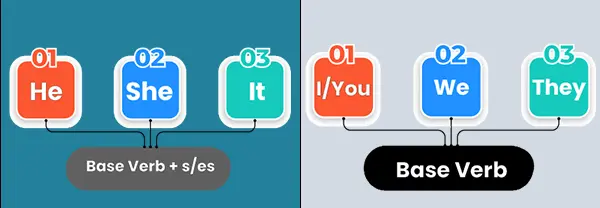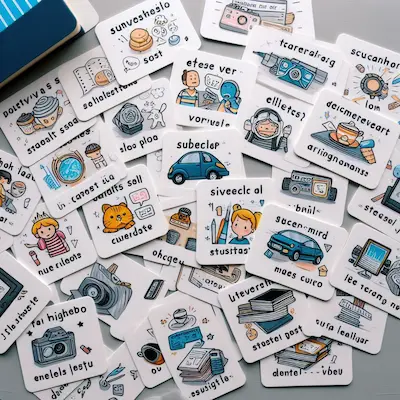Hello, language enthusiasts! Today, we’re embarking on a journey through the realms of grammar, and our destination is the Present Simple Tense. Think of it as the plain white T-shirt of the English language wardrobe – fundamental, versatile, and timeless. Let’s make grammar not just informative but also fun and accessible.
What is the Present Simple Tense?
The Present Simple Tense is one of the most basic structures in English. It’s the go-to when we want to describe habits, universal truths, facts, and routines. Imagine it as your everyday routine captured in words – it’s simple, it’s present, it’s factual.
When to Use It:
- Habits and Routines: When you talk about things you do regularly, like brushing your teeth or walking the dog.
- Permanent Situations: When something is generally true, such as “The Earth orbits the Sun.”
- General Truths: For facts that are not just true now but always, like “Water boils at 100 degrees Celsius.”
- Scheduled Events (in the near future): For timetables or schedules like “The train leaves at 6 PM.”
- Feelings and Emotions: When expressing likes, dislikes, or preferences – “I love chocolate.”
- Instructions and Directions: For giving step-by-step guidance or directions.
The Structure of Present Simple
Picture a tree. The subject is the trunk, the base of every sentence. Now, the verb – that’s the branch. In Present Simple, that branch is either in its base form, like ‘run,’ or with an ‘s’ at the end of the subject is ‘he,’ ‘she,’ or ‘it.’
Here’s the formula:

- I/You/We/They + Base Verb: “I run every morning.”
- He/She/It + Base Verb + s/es: “She runs every morning.”
Now Imagine the present simple tense as a construction site, where you’re building clear and concise sentences about things that happen regularly or habitually. Let’s grab our tools and get started!
The Foundation: Subject and Verb
- Subject: This is the who or what doing the action. Think of it as the sturdy base of your sentence, like the strong foundation of a building.
- Verb: This tells us what the subject is doing. It’s like the bricks and mortar that bring the sentence to life. In the present simple, we use the base form of the verb (e.g., “play,” “eat,” “think”).
Adding the “s” for Third Person Singular:
- But wait! For third-person singular subjects (he, she, it), we need to add an “s” to the verb. It’s like putting a special finishing touch on the top floor of the building, making it stand out.
Building Questions and Negatives:
- Want to ask a question? No problem! Just grab the auxiliary verb “do” or “does” (depending on the subject) and place it before the subject. It’s like adding a scaffolding to the building, allowing you to inspect it from different angles.
- To make a negative sentence, simply pop “not” in between the auxiliary verb and the main verb. It’s like putting up a “no entry” sign on the building, indicating that the action isn’t happening.
Time Adverbs: The Finishing Touches
- To paint a clearer picture of when the action happens, we use time adverbs like “always,” “often,” “sometimes,” “never,” and “every day.” These are like the colorful decorations and landscaping that make the building feel complete and give it a sense of context.
Here are some examples to bring it all together:
- Subject + Verb: I play basketball. (The base form of the verb “play” is used because the subject is “I,” which is not third-person singular.)
- Third-Person Singular: She speaks French. (An “s” is added to the verb “speak” because the subject is “she,” which is third-person singular.)
- Do they live in London? (“Do” is used because the subject “they” is plural.)
- Negative: I don’t like coffee. (“Not” is placed between “do” and “like” to make the sentence negative.)
- Time Adverb: We always go to the beach on Sundays. (“Always” tells us that the action of going to the beach happens regularly on Sundays.)
Bonus Tip:
Think of the present simple as a snapshot of a recurring action. It’s like capturing a single frame from a movie that shows what happens over and over again.
Now go forth and build your own clear and concise sentences with the present simple! Remember, the foundation is strong, so be creative and have fun!
Extra Bonus Tip:
To practice forming present simple sentences, try playing a “Who does what?” game. Think of different characters and their typical actions, then describe them using the present simple structure. Have fun and get creative!
Common Mistakes to Avoid
- Forgetting the ‘s’ in the third person singular: Remember, ‘he’ ‘she’ ‘it’ – they always need the ‘s’. It’s like forgetting an umbrella on a rainy day – you can manage without it, but it’s not quite right.
- Overusing ‘do’ and ‘does’: Use ‘do’ and ‘does’ in negative sentences and questions. For example, “She does not like spicy food,” not “She does like spicy food.”
Tips to Master the Present Simple
- Listen and Repeat: Tune into English podcasts or songs. When you hear the Present Simple, pause and repeat the sentence.
- Practice Makes Perfect: Write down your daily routine using the Present Simple. It’s like drawing – the more you do it, the better you get.
- Quiz Yourself: Create flashcards with different subjects and verbs, and practice making sentences. It’s like a mini-game with words.
- Speak Up: Try speaking with friends or language exchange partners. It’s like dancing – the more you move, the smoother you get.

Present Simple Tense Test
Challenge your language skills with our Present Simple Tense Test – a fun and insightful way to master the fundamentals of English grammar. Take the test now!
Conclusion
The Present Simple Tense doesn't have to be daunting. It's the basic building block for expressing so much of our daily lives in English. By understanding when and how to use it, you can share your world with others in clear, accurate terms. So, embrace the simplicity of the Present Simple and incorporate it into your linguistic toolbox – it's a tool you'll use every day!
Remember, the more you use it, the more natural it will become. Happy learning, and may your grammar journey be as simple and enjoyable as the Present Simple Tense itself!
